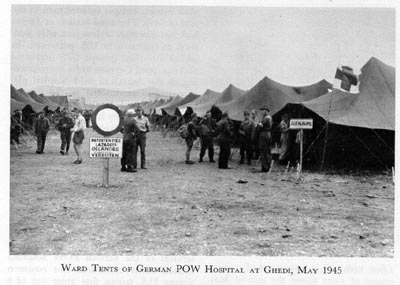The Ghedi POW Camp
The Ghedi POW Camp

In May 1945, the German units that gave themselves up to the advancing Fifth Army were grouped together and taken into various POW cages scattered all over the Po Valley. The largest of these was set up at Ghedi, about twenty miles southwest of Desenzano and a somewhat shorter distance south of Brescia. A smaller concentration area was located at Modena, with others of lesser importance at Parma, Piacenza, Montichiari, Brescia, and Verona. Sanitation of all prisoner enclosures in northern Italy was under the supervision of Maj. Frank H. Connel. Just after the surrender, it was necessary to remove scrap and garbage by truckloads, disinfest the prisoners with DDT and give them typhus inoculations.
In the beginning, the German prisoners were shared between the camps of Ghedi and and Modena, with a parallel organisation of field hospitals of 100 beds or more, as intermediary stations from where the patients were to be later moved to the larger hospitals. As soon as adequate lines of communication could be established, all long-term prisoner patients were to be concentrated at Merano.
During the period of consolidation, one or more medical officers of the 2d Auxiliary Surgical Group were stationed at each of the German hospitals to keep a check on the number of patients and their care. As had been the case at Merano, German doctors for the most part were so anxious to disassociate themselves from the Nazis that willing co-operation was assured. No attempts to evade or mislead in any particular were noted. A German increment, with two medical officers, was attached to Fifth Army headquarters, and the German Director of Medical Services aided in the assignment and disposition of enemy medical units.
In May the 85th and 88th Divisions guarded captured dumps in the mountains and moved surrendered German forces to concentration areas. The Ghedi POW enclosure was guarded by the 10th Mountain Division until 18 May, and thereafter by the 71st Antiaircraft Brigade with the 442d Infantry regiment under its command. The 88th Division took over all guard duties when it became the POW command. By this time all prisoners in the Fifth Army area had been moved to Ghedi or Modena. Some 80,000 entered the Ghedi cages in the week of 17-24 May alone. Modena was considerably smaller, being limited to about 20,000 by poor drainage.
Medical service at Modena was supplied by German doctors under supervision of the l5th Field Hospital's 3d Platoon. At Ghedi a 1,600-bed tent hospital was erected, staffed entirely by German medical units nominated by the German Director of Medical Services. Lt. Col. (later Col.) Harris Holmboe was chosen by General Martin as medical coordinator in the Ghedi area. The Modena and Ghedi hospitals were to care for personnel in the prisoner of war enclosures only, and were not a part of the consolidation plan.
By the end of May about 80 percent of all German medical personnel, equipment, and patients had been transferred to Merano and Cortina d'Ampezzo. A German-staffed 1,500-bed convalescent hospital was established the first week of June at Villafranca, under supervision of the U.S. 3d Convalescent Hospital. Patients expected to recover within four weeks were transferred here from Merano and Cortina, and on recovery were moved to the Ghedi POW camp. By 15 June, six weeks after the victory, all German hospitals under Fifth Army control had been closed except Merano, Cortina, the convalescent facility, and the units serving the Modena and Ghedi areas. In another two weeks the hospitals at Cortina d'Ampezzo were also cleared to Merano and closed. The convalescent hospital was disbanded on 17 July. German medical supplies and equipment were stored at Merano and Ghedi, while German hospitals and other medical units, as they became surplus, were held at Ghedi for shipment to Germany or Austria on call.
At the end of June there were about 12,000 patients in the German hospitals at Merano, administered by the 380th Medical Collecting Company of the 54th Medical Battalion. There were about 4,000 members of the German medical service in the town. Many items of medical supply were manufactured there, and 9,000 tons were stored. Supplies not needed to care for patients at Merano were shipped to PBS and to British bases for use in treatment of German personnel. The town itself was run by the 88th Division under strict military control.
Merano offered an excellent opportunity to evaluate German medicine, about which little had been known since the Nazi regime had come into power. Consultants and medical investigators from all parts of the theater and from the United States visited the area during the period of its heaviest operation. The conclusion was general that while the German medical service was adequate, its standards "were only mediocre in comparison with those of the Allied Forces in Italy."[...]
(Summarized from http://www.armymedicine.army.mil)
BACK TO INDEX

